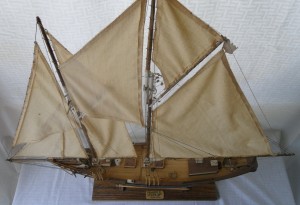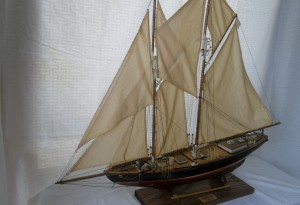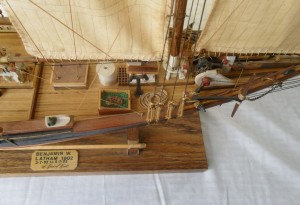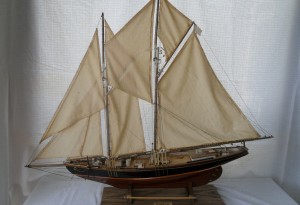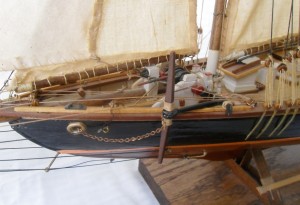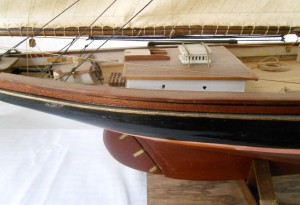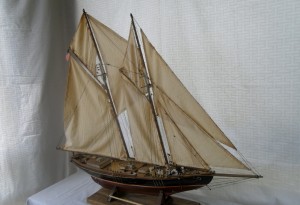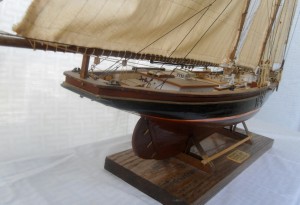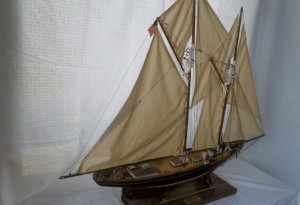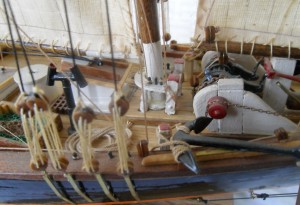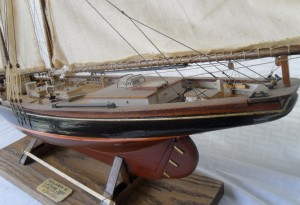Boat Name: Benjamin W. Latham
Year Launched: October 30, 1902
Country: United States
Constructed By: Thomas F. McManus of Boston for Captain Henry Langworthy of Noank, Connecticut in the shipyard of Tarr & James at Essex, Massachusetts.
Size: 72 tons
Crew: 15
Actual Dimensions of Model: 1/48. Length 32 inches Height 27 inches
Year Model Built: March 7, 2002- May 7, 2002
Historical Significance:
The northward spring migrations of the American mackerel gave rise to one of the most interesting & speculative facets of the New England fisheries in the second half of the 19th century & early 20th century. Many methods were developed to capture these wily & unpredictable fish, the most successful being the purse-seine, a large net which was set in a ring around a mackerel school and then closed by “pursing”, or drawing its bottom edge together with a “purse line”, thus forming a bag from which the trapped fish were baled with large dipnets.
The development of the purse-seine also led to the development of the seine boat, a large double-ended boat from which the net was set. This boat supposedly evolved from the New Bedford whale boat but was soon modified and enlarged as seine nets became larger. Attendant to this technology was a wide variety of boat & net gear of special design. Because the schooners themselves were specifically rigged and fitted for these operations they assumed a distinctive appearance.
The schooners of the mackerel fleet varied considerably in size at the end of the 19th century. Prior to 1880, vessels suitable for this work usually measured 60-80 tons, but with the introduction of new hull types & incentives to increase the sizes of new schooners, the early 1900’s saw schooners of 120 tons and more, being fitted out for mackerel seining. Auxiliary power was introduced, nets and boats increased in size, double-crews and gear were carried in the largest vessels. Finally in the 1920’s , the seine boats were fitted with engines. The last innovation was made necessary by the nets, which became so large they could not be set and pursed quickly enough under oars alone.
Nearly every vessel in the Noank fishing fleet was fitted for mackerel seining in the early 1900’s and this undoubtedly was the principle activity of the Benjamin W. Latham. First registered as a sailing vessel, she was fitted with a 48 horsepower gasoline engine sometime in her second or third season. This would have dictated that her propeller shaft be fitted off-center, either to port or to starboard. Since a seiner “bailed the seine” (removed the fish from the net) to starboard, it would seem wise to have the screw to port to avoid fouling the nets.
In keeping with most fishermen, Latham’s career goes mostly undocumented. She is known to have accommodations for a crew of fifteen, and because of her size, she was a “one-boater” (towed one seine boat). If the seine boat was a 40-footer, it would always have been towed astern, since there was no deck room for it aboard the schooner.
In 1906, Latham was re-registered at New York and operated out of the Fulton Fish Market. What sort of fishing she did at this time is not known, although it seems likely she was converted to dory trawling. Very likely she would have been cut down in rig in the 1920’s, working mainly under power thereafter. What she looked like in 1939 under Puerto Rican ownership is not known. She was lost in 1943 off San Juan, Puerto Rico.

